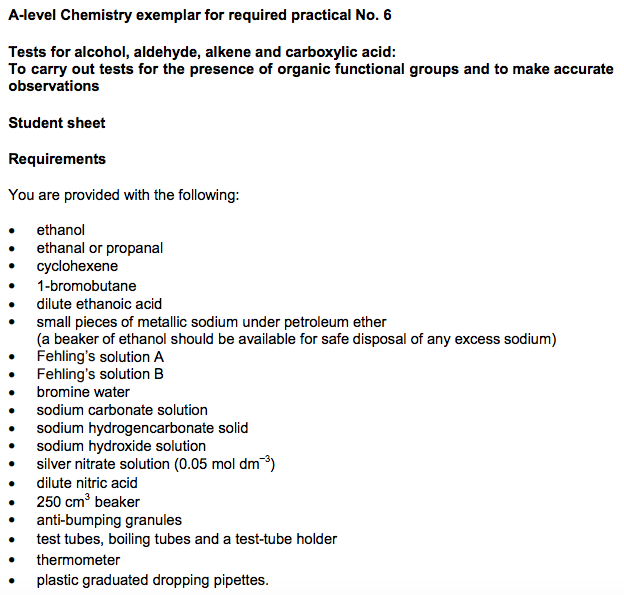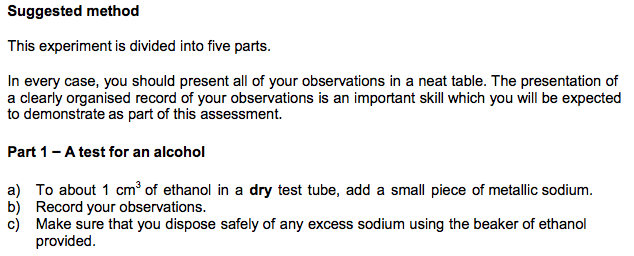


A-level Chemistry exemplar for required practical No. 6 Tests for alcohol, aldehyde, alkene and carboxylic acid: To carry out tests for the presence of organic functional groups and to make accurate observations Student sheet Requirements You are provided with the following: ethanol ethanal or propanal cyclohexene 1-bromobutane dilute ethanoic acid small pieces of metallic sodium under petroleum ether (a beaker of ethanol should be available for safe disposal of any excess sodium) Fehling’s solution A Fehling’s solution B bromine water sodium carbonate solution sodium hydrogencarbonate solid sodium hydroxide solution silver nitrate solution (0.05 mol dm –3 ) dilute nitric acid 250 cm3 beaker anti-bumping granules test tubes, boiling tubes and a test-tube holder thermometer plastic graduated dropping pipettes. Suggested method This experiment is divided into five parts. In every case, you should present all of your observations in a neat table. The presentation of a clearly organised record of your observations is an important skill which you will be expected to demonstrate as part of this assessment. Part 1 – A test for an alcohol a) To about 1 cm 3 of ethanol in a dry test tube, add a small piece of metallic sodium. b) Record your observations. c) Make sure that you dispose safely of any excess sodium using the beaker of ethanol provided. Part 2 – A test for an aldehyde using Fehling’s solution. a) In a clean test tube mix together equal volumes of Fehling’s solution A and Fehling’s solution B. The resultant Fehling’s test reagent should be a clear dark blue solution. b) Add 5 drops of this test reagent to about 1 cm 3 of sodium carbonate solution in a test tube containing a few anti-bumping granules and then add about 1 cm 3 of ethanal (or propanal) to this same test tube. c) Warm the test tube gently for approximately 2 minutes in a beaker half- filled with hot water and then gradually bring the beaker of water to boiling and maintain this temperature for a few minutes. d) Using the test tube holder, carefully lift the test tube out of the boiling water and allow its contents to stand for several minutes. Record your observations. Part 3 – A test for an alkene (a test for unsaturation) a) To about 2 drops of cyclohexene in a test tube, add about 1 cm3 of bromine water and shake the contents of the tube vigorously from side to side. b) Record your observations. Part 4 – A test for a carboxylic acid a) Place one small spatula measure of solid sodium hydrogencarbonate in a boiling tube tube and add to it about 2 cm 3 of dilute ethanoic acid. b) Record your observations. Part 5 – A test for a halogenoalkane a) Using a teat pipette, add 5 drops of 1-bromobutane to about 1 cm3 of sodium hydroxide solution in a test tube. Warm the contents of the test tube for a few minutes, by placing it into a beaker filled with hot water at approximately 60 °C. b) Acidify the contents of the test tube by adding 2 cm 3 of dilute nitric acid and then add about 1 cm 3 of silver nitrate solution. c) Record your observations.
/
~
~
~
/
Required practical 6
Tests for alcohol, aldehyde, alkene and carboxylic acid.


 Practical Guide Page : 125 - 126
Practical Guide Page : 125 - 126 Oxford Textbook Pages : 517
Oxford Textbook Pages : 517 CGP Revision Guide Pages : 154 - 156
CGP Revision Guide Pages : 154 - 156